From the east coast of India, more accurately from the airport of the city of Chennai, federal state Tamil Nadu, Sneža and I transferred by plane in the north-west direction to the city of Pune, federal state Maharashtra, and then by coach farther to the city of Aurangabad, also in Maharashtra. This transfer to Aurangabad was efficient, although with a delay and filled with adventure.
Namely, when we landed at the airport in Pune, we first inquired around about our next steps. In line with that we took an auto rickshaw to a transportation agency. There we bought the tickets and we were told the coach would pass by and pick us up in 5 minutes. The coach was expected any minute and they told us we did not have the time even to go and buy some water. Although we were delighted that we had a connection right away, we were still a little concerned by the fact we would be without any water, but through a quick action I managed to provide both water and some food for the trip. However, the time was passing. 10-15 minutes. The guy who had sold us the tickets was just getting onto a motorbike with a friend ready to leave. Before he managed to leave, I asked him what was happening with our coach and he told me I should ask the others who were now sitting at the desk where he had sat before and where we had bought the tickets. And so we did, but then these people told us the coach was at the other end of the city and that we should actually go there. What???
That’s when all hell broke loose. The coach was supposed to pick us up at 3.45 pm, it was already 4 pm and in fact all this time it was us who were actually supposed to go somewhere and no coach was ever to come and pick us up, only nobody bothered to tell us so, quite the contrary, they told us something completely different from the reality. Then we started asking for our money back and they first agreed, but then they started getting an auto rickshaw for the two of us which they paid for. In all of this rush, we barely managed to pack us and our two backpacks into the rickshaw and everything was happening incredibly quickly. Sneža was out of her mind, but there was practically nothing she could do, while I was ready to do calmly as we were told and wondered if I was wrong about it and if Sneža would later rub my nose in it if we get let down. From the auto rickshaw it seemed to me the driver was taking us back to the airport, but then I suddenly saw a board with the name of the company – it was actually their other “office” and there it was – the coach was there waiting for us. We were driven right to the coach, the luggage went into the luggage storage for the first time and not with us into the coach, we went in, took our seats and the coach finally left at 4.15 pm, half an hour late, because they were actually waiting just for the two of us.
Sneža was still in the state of shock and she did not like the whole thing at all since it was all pure improvisation, but in the end I was delighted. Needless to say, I would prefer the European efficiency and manner of managing things, but what delighted me was in fact something completely different. It was the feeling of learning. The feeling that just as I thought I had comprehended how things function in India, India took a virtual twig and tapped me on my head in order to remind me that she cannot be mastered so quickly and easily, and that she is full of surprises at any given moment. Also, that things can work out even when they are not done in the Western way.
What I did not like in the coach, however, (which was the best until then) was that the air-conditioning worked like mad and I was freezing. The problem was that about a week earlier I started to cough and have sore throat and I could not get better with this constant moving around and with the frequent changes of the cold and hot settings. So, I did not appreciate this very low temperature in the coach at all and when we stopped at a petrol station to make a break, I took the opportunity to get the little blanket (the one I kept from the plane from Europe to India) from my backpack and that felt quite good for a while until the night started to fall and then the driver suddenly turned off the air-conditioning completely and at that same moment it became incredibly hot inside.
But, that was yet another lesson, admittedly linked not solely to India. For some reason that escapes me, in many countries in the tropical climates in which I have travelled by coaches, the drivers like to use the air-conditioning in an extreme way, i.e., they turn it up to the maximum. I personally find this to be a big problem, since by the rule it is very hot in such places, most often with very high air humidity, then I’m all sweaty and when I enter an extremely cooled coach in such a state, this sudden and big change in the temperature does not suit me and practically the same day I start to have sore throat. However, after this concrete experience from India, several months later, when I travelled around Central America, I packed a little blanket already at home, along with a thicker, long-sleeve cotton shirt and as soon as I entered a coach, I would immediately put that shirt on and wrap myself in the blanket. In this way, joyous and happy, as well as healthy, I successfully completed this other journey of mine.
But, let me go back to the story about India and the arrival in Aurangabad.
When we finally reached Aurangabad we first had some hassle about finding accommodation since we could not book anything in advance. In the end, however, we did settle well and it turned out that there was a restaurant at the hotel with extremely nice and kind maître d’. There we had nice dinner and we liked the food so much that we decided immediately we would have dinner there the following evening as well.
Still, after leaving our things in the room and before the dinner, we went out of the hotel and in the vicinity we found something like a tourist/transportation agency where we agreed a driven car for the entire following day. We had very ambitious plans, since we were supposed to get to two very important sites that are located at two different sides. The plan was that we first went to Ellora Caves and then to Ajanta Caves that were farther away, so we thought that as far as the timing was concerned it would be better to visit the latter later.
The following day, however, started with certain problems. First it turned out we did not have enough rupees, so we had to go by that hired car to an exchange office. It turned out that there was no place close to the hotel where we could change the money and we had to enter the central part of the city where it was extremely crowded and thus we lost some very valuable time.
The guy with whom we had agreed the car, who was with us in the car (the car was driven by some young man), told us that the car was actually going to cost more since it was a slightly bigger model than the one we had agreed on the night before. We complained and then the argument ensued. Under any normal circumstances, both Sneža and I would simply get out of the car and would not even try to argue. However, we had already lost a couple of hours and did not even know where we could actually find another transportation, and we had no more days for the sightseeing, and thus we felt stuck with him, so we just kept on insisting on the already reached agreement. In the end, he “accepted” to the already agreed price, but then he left the car and told us that we would not have the guide after all (I guess it was supposed to be him, although we did not talk about it, let alone agreed anything to that effect), while the young man who drove the car did not speak a word of English.
So we finally headed for Ellora Caves.
After the drama and the experience of the transportation from Pune, probably also because of the general fatigue that had collected in us since we had kept moving from one place to another almost every day for the past three weeks, both Sneža and I first fell silent and then we both entered the state of mild hysteria, trepidation and suspicion about everything around us, so we wondered aloud what if this guy took us to the Ellora Caves, only around 30 km and some 40 minute drive away from Aurangabad, and then disappeared (in the meantime we had already had to pay for the entire hire of the car). So, half way we told him to turn the car and take us to Ajanta Caves. Our logic was that if he abandoned us somewhere it would be better to do it at a farther site. This actually does not make much sense, but that was how the two of us were thinking at the time.
Be as it may, the guy did understand us, he did turn the car and thus we reached Ajanta Caves that are around 100 km away from Aurangabad, which was over two hours of drive. Because of the whole mess with the waste of time and the taxi driver, both Sneža and I felt rather low. However, the beauty of the caves, the reliefs, sculptures, paintings and nature was enchanting and soon after our arrival at the site the two of us forgot all the problems we had faced that day.
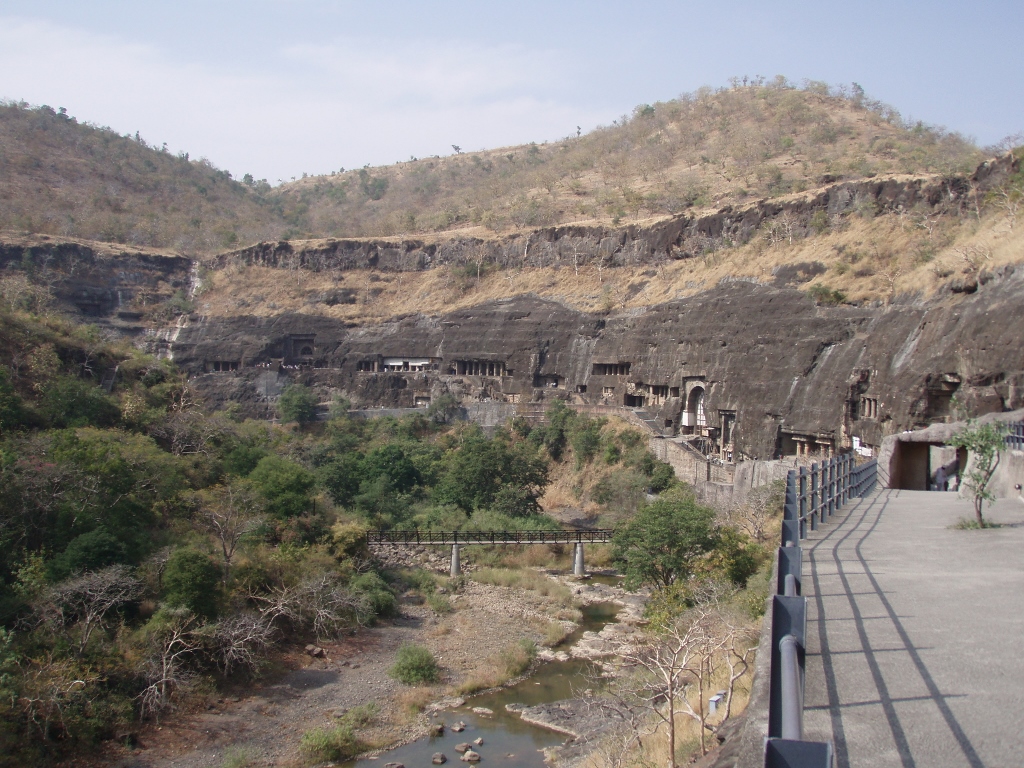 Ajanta Caves and the canyon of the Waghora river
Ajanta Caves and the canyon of the Waghora river
These are 30 caves that are not natural caves at all in fact, but rather they were made by human hand in the rocks of the canyon of the Waghora river, which at this point makes a large curve, in the period from the 2nd century BCE to the 5th century CE.
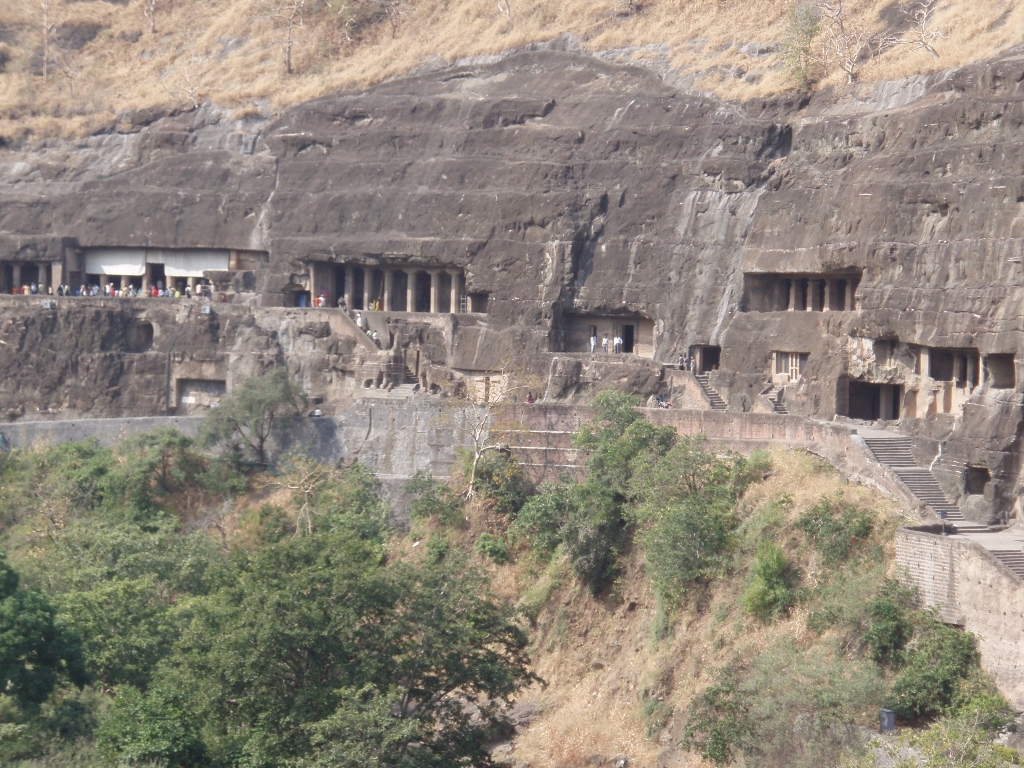 Ajanta Caves
Ajanta Caves
All the caves at this site were made by Buddhist monks, but as the historians assume, with the “construction” of the caves in Ellora, these ones here lost their importance and were eventually abandoned. Then the time took its toll and this whole canyon got overgrown by lush vegetation, while the caves became hidden. And so this continued until 1819 when a group of British hunters passed here, accidently stumbling upon the caves which since then saw the light again.
Today, they are not all open to visitors, but most of them are, although some caves are closed from time to time in order to conduct restoration works. Namely, in addition to some extraordinary plastic decorations and sculptures, the caves also contain numerous wall paintings that are priceless.
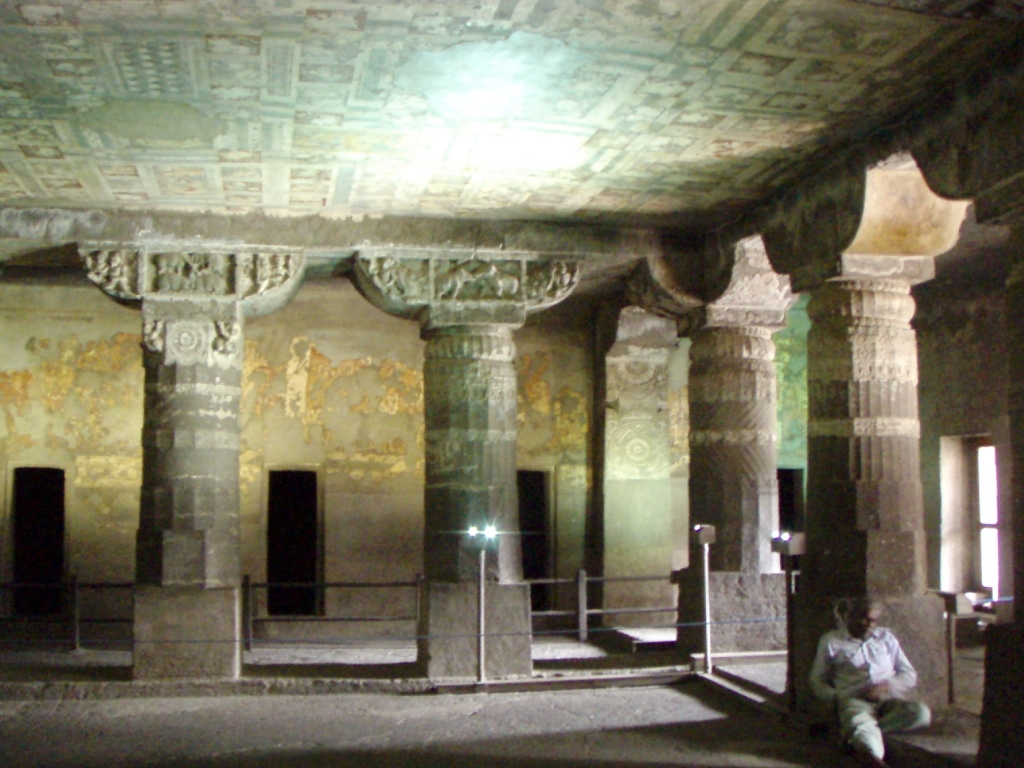 Ajanta Caves, interior of Cave no. 1
Ajanta Caves, interior of Cave no. 1
Already in the first cave we visited (Cave no. 1) we began to learn some general rules and details. To start with, at the entrance into the respective cave there is a door installed in order to cut down on the number of bugs that could possibly enter and in order to maintain more efficiently the climate inside to help preserve the paintings better.
Also, it was not allowed to film with a video camera inside, while the lighting was rather specific – some natural light coming in through the windows mixing with artificial light – so my photos are of different quality, but they will certainly provide a decent idea about some details from the interior of the caves.
By their architectural concept, Ajanta Caves are divided into two groups. The first group comprises halls, temples or shrines for praying that are called chaitya-griha and that at the back, opposite the entrance, have a votive stupa and a semi-circular apse, in addition to which they are also characterised by a vaulted ceiling. The other group consists of the so-called monasteries, the viharas. They are large halls, with rectangular or square ground plan, that have along their walls hollowed-out small cells for the placement of monks, while in the wall opposite the entrance there is the main sanctum.
Cave no. 1 belongs precisely to the monastery type and it is one of the bigger caves in Ajanta; the sides of the central hall are each 12 metres long, while the hall itself is 6 metres high. In the photo above it is possible to see nicely the caves that are entered from the central space and there are also some 20 carved and painted pillars that decorate the cave.
Like in the other caves, to a larger or lesser extent, here, too, it is possible to see numerous murals.
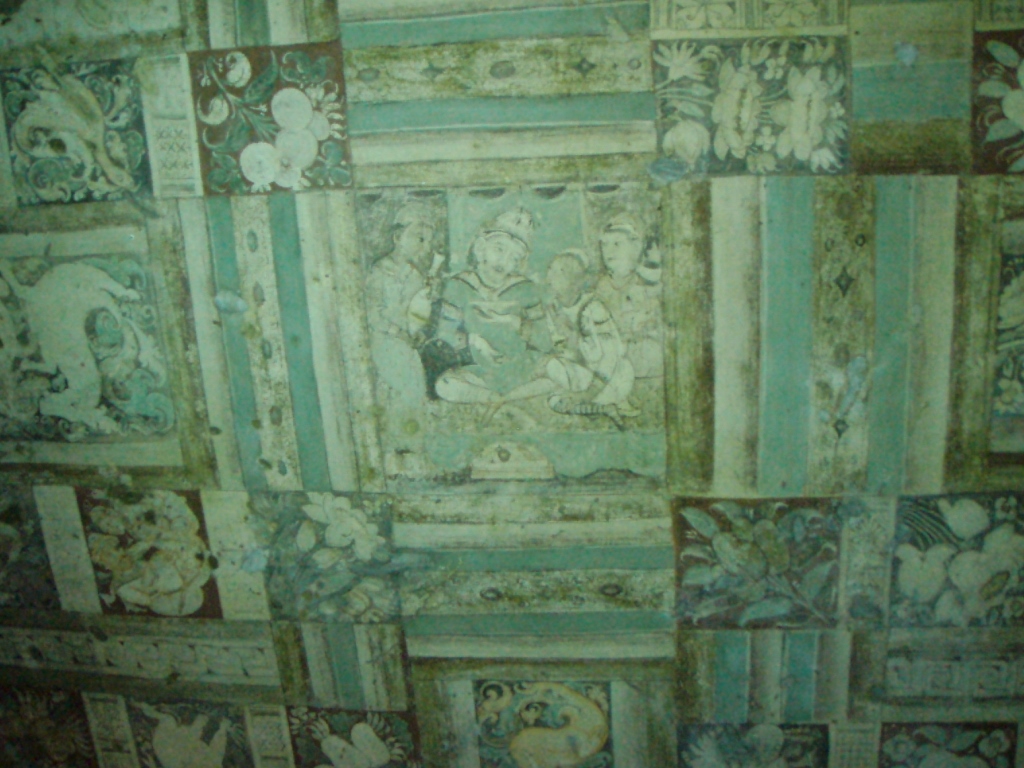 Part of the ceiling in Cave no. 1
Part of the ceiling in Cave no. 1
One of the better known wall paintings from Ajanta is certainly Padmapani (Lotus-Holder) from Cave no. 1 that depicts the Bodhisattva of Compassion. By the way, bodhisattvas are all persons who are on their way to enlightenment, but have still not attained it and who, although they may go into nirvana, stay at this plane of existence with full awareness in order to help others.
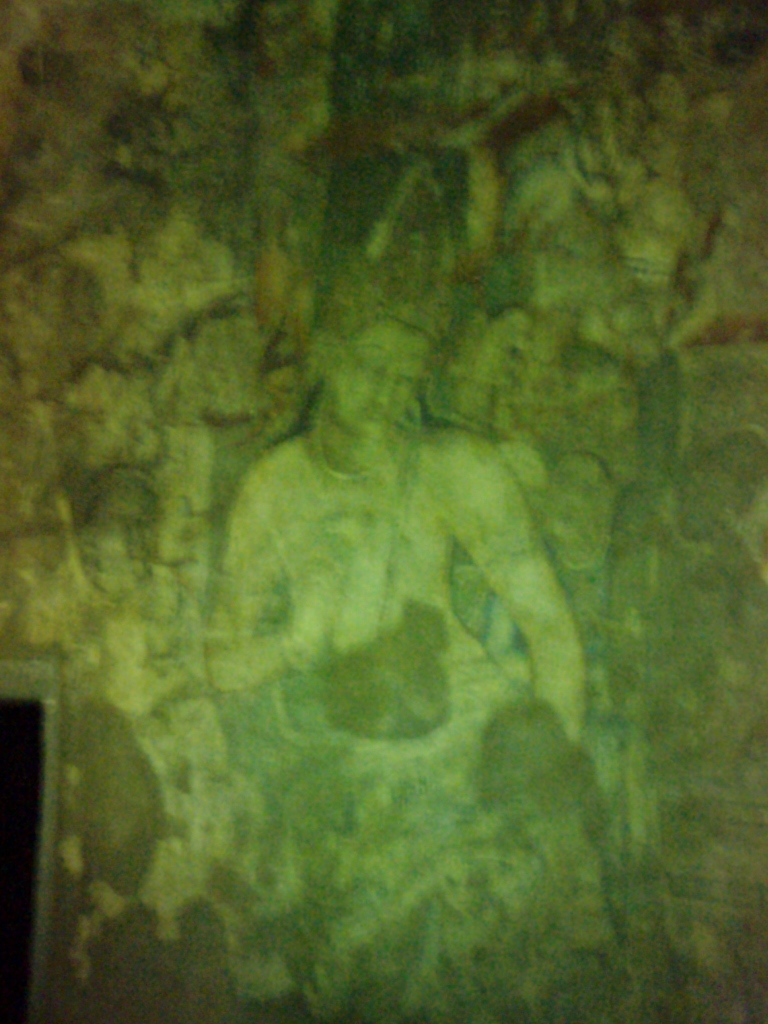 Bodhisattva of Compassion
Bodhisattva of Compassion
As it may be seen in the next photo, Cave no. 1 is wonderfully decorated also from the outside.
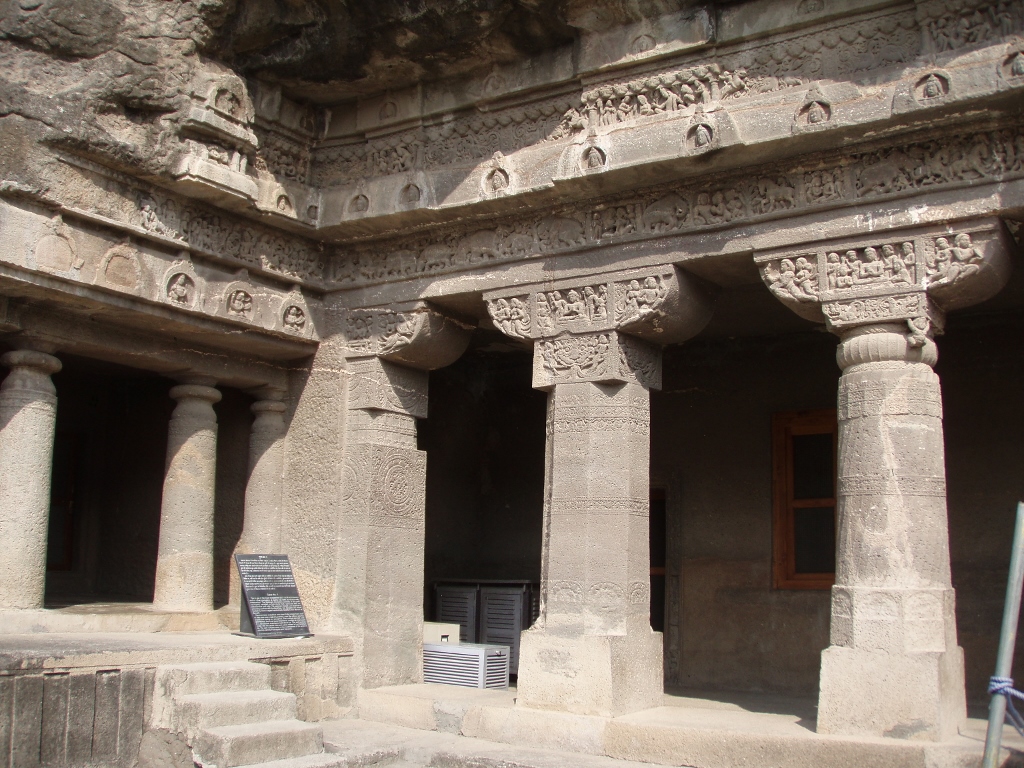 Opulently decorated side part of the veranda in front of Cave no. 1
Opulently decorated side part of the veranda in front of Cave no. 1
The next one was, of course, Cave no. 2. It contains a lot of murals that are in a somewhat better shape than those from the first cave we visited.
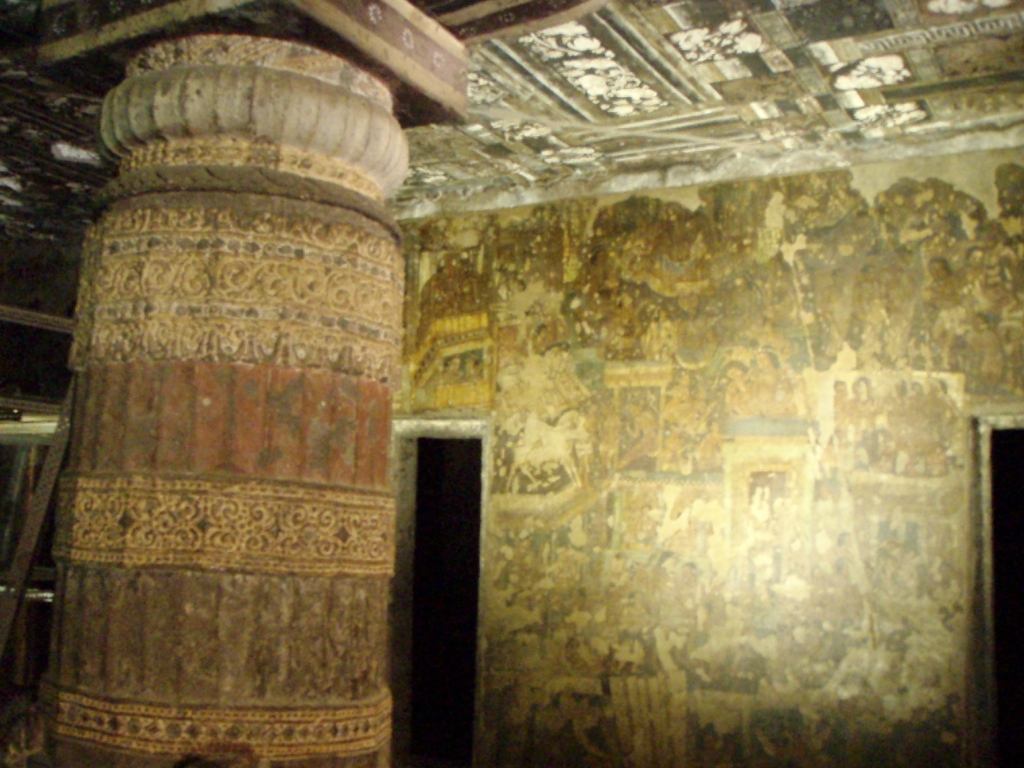 Cave no. 2, detail
Cave no. 2, detail
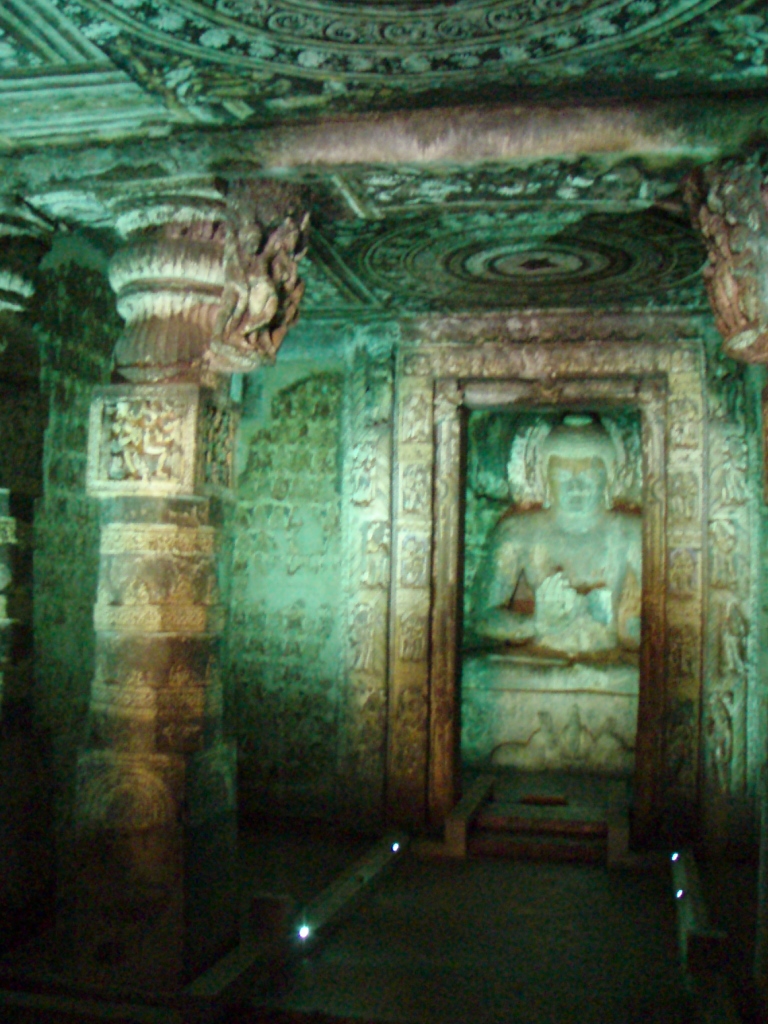 Cave no. 2, details and the inner sanctum
Cave no. 2, details and the inner sanctum
When we got out, we were greeted by a local resident who seemed to have forgotten to have its hair cut.
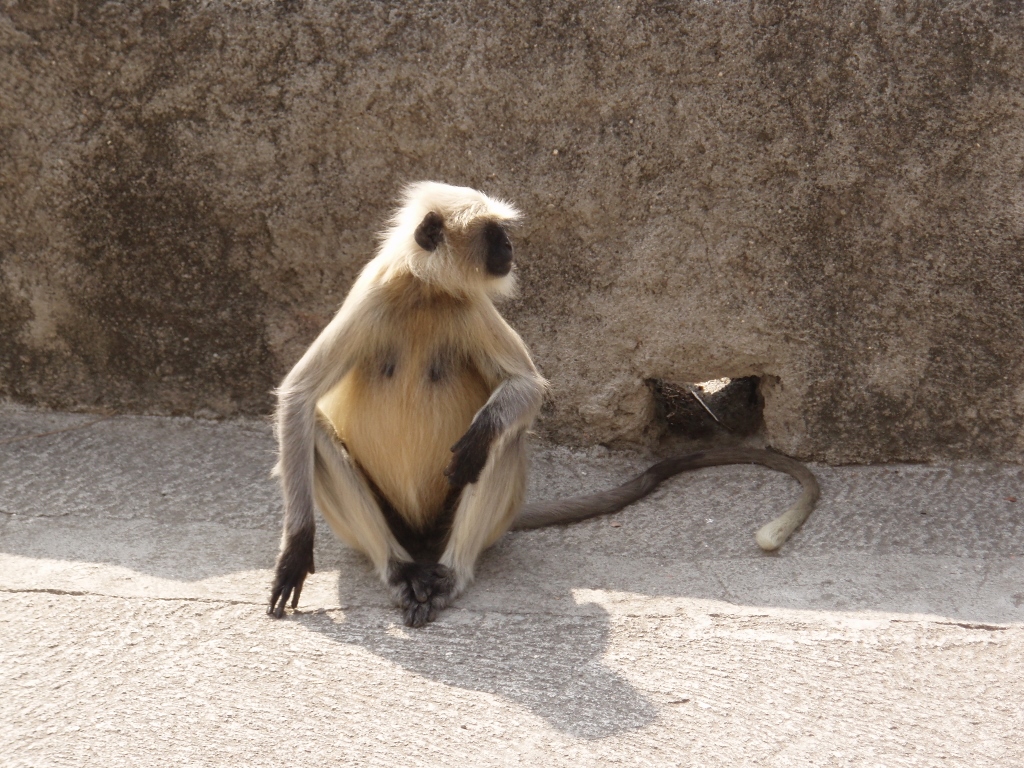 There are visitors in Ajanta, but there are also local residents
There are visitors in Ajanta, but there are also local residents
Then we came to Cave no. 4. It is the biggest cave within the complex in Ajanta, 35m x 28m, and it also belongs to the vihara type, i.e., to the group of monasteries, with a central hall and small rooms on the side for the placement of monks.
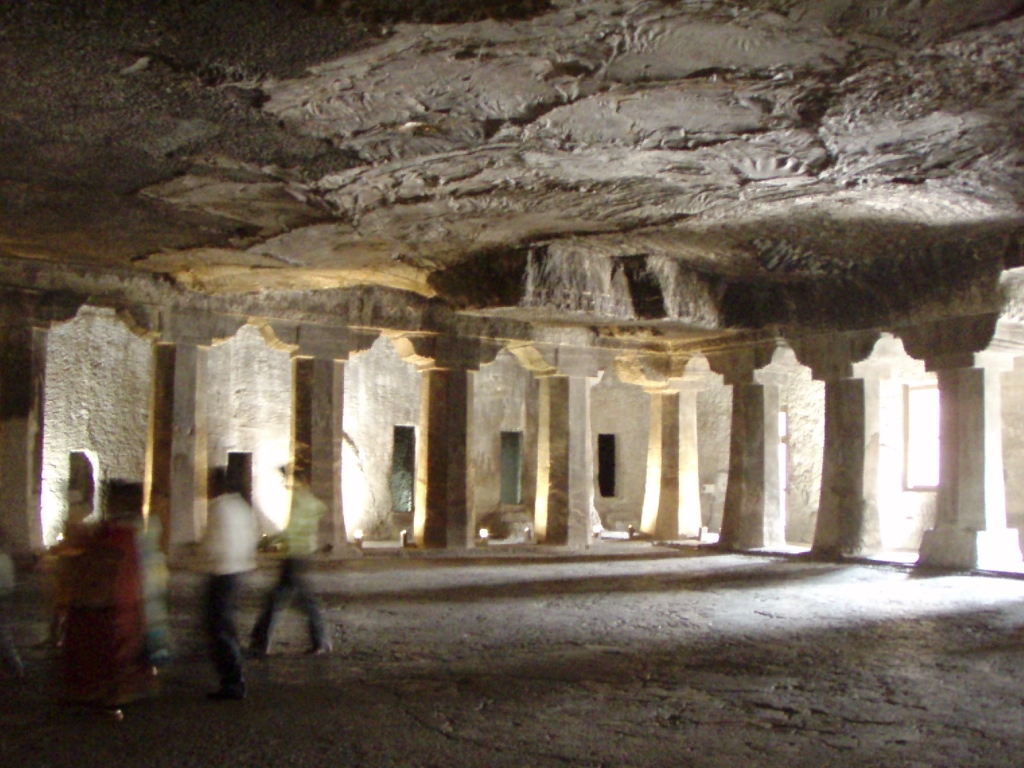 Cave no. 4
Cave no. 4
Although not finished, it is not any less impressive. Especially some of its decorations are amazing.
As I’ve said, all of these caves in Ajanta are Buddhist and thus their decorations are from the sphere of the Buddhist iconography. As it may be seen in one of the photos above, here in the central sanctum there is a sculpture of Buddha, as opposed to the Hindu temples where we mostly came across those dedicated to Shiva and therefore the central sanctum contained a lingam.
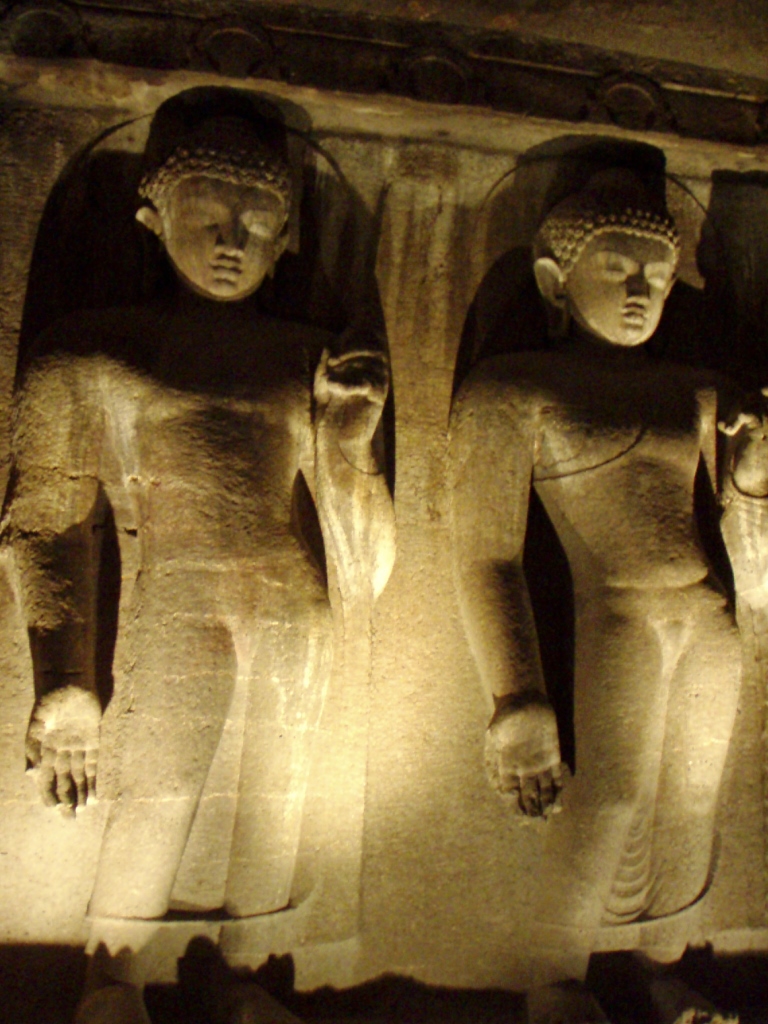 Wall decorations in Cave no. 4
Wall decorations in Cave no. 4
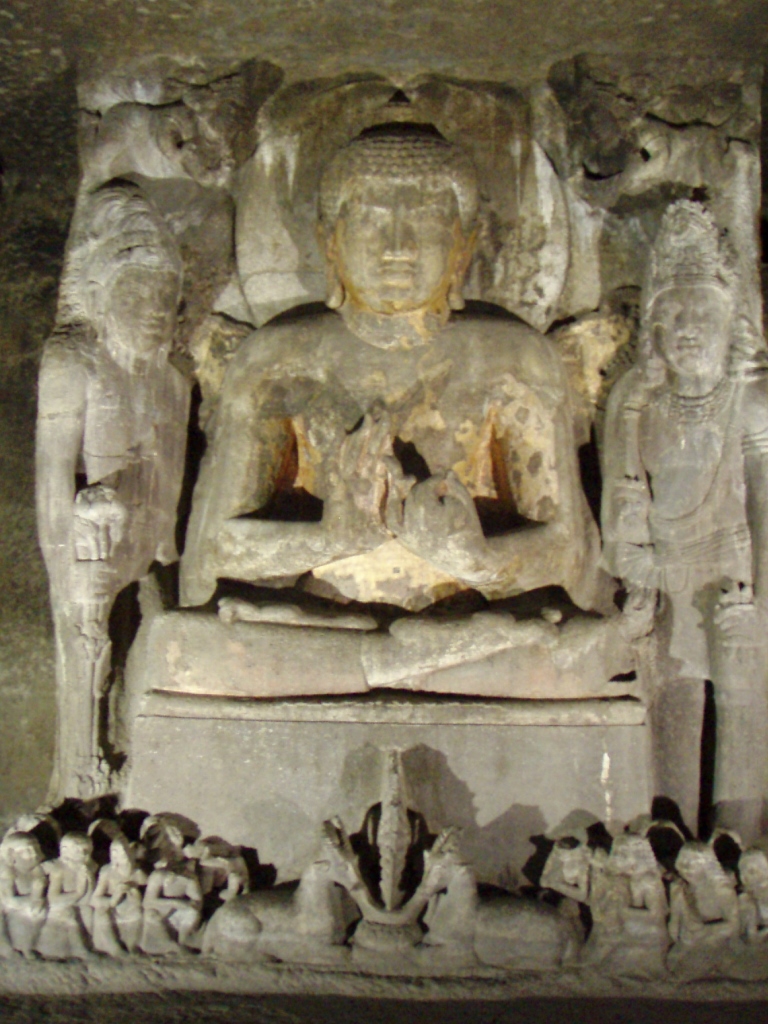 Buddha in the central sanctum in Cave no. 4
Buddha in the central sanctum in Cave no. 4
The next cave in Ajanta I would like to mention is Cave no. 6. That is the only cave in Ajanta that has two floors. Both floors contain monks’ cells, while in the central sanctums on both floors there is Buddha whose depictions may also be seen in some other places within the cave.
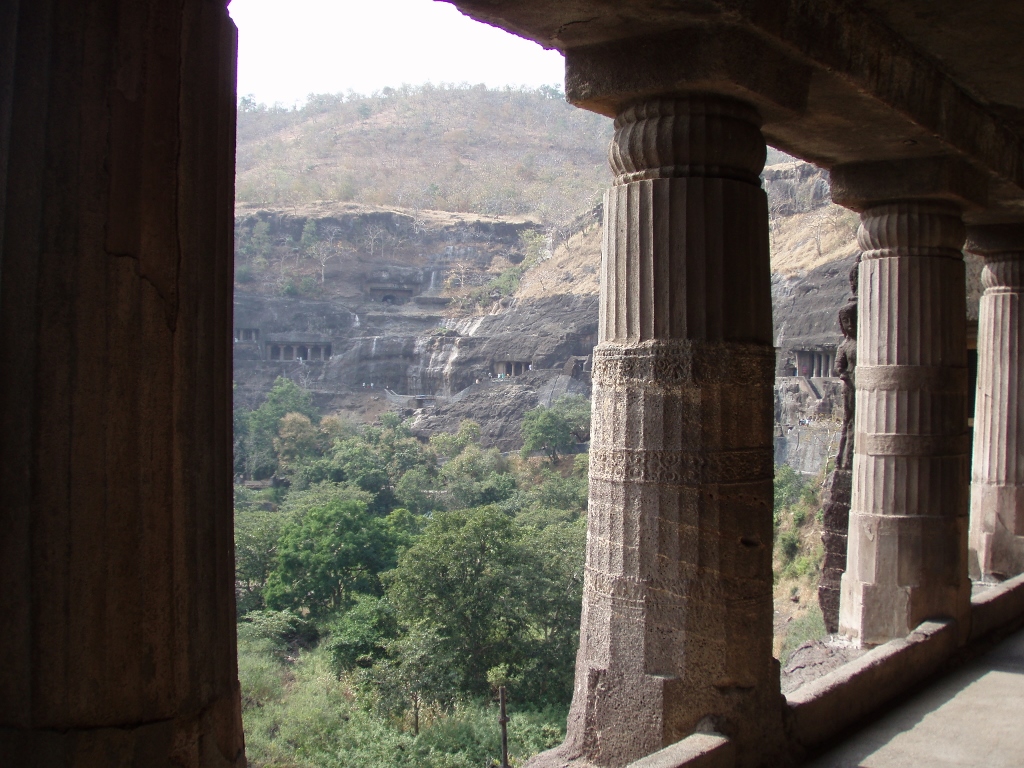 View at the canyon of the Waghora river from the upper floor of Cave no. 6
View at the canyon of the Waghora river from the upper floor of Cave no. 6
At the entrance into this cave there is a beautiful mural with Buddha in the centre. Taking into account the age of these wall paintings for which Ajanta Caves are perhaps best known and how much humidity, dampness, moisture, heat and other different natural impacts there have been, they are in fact unbelievably well preserved.
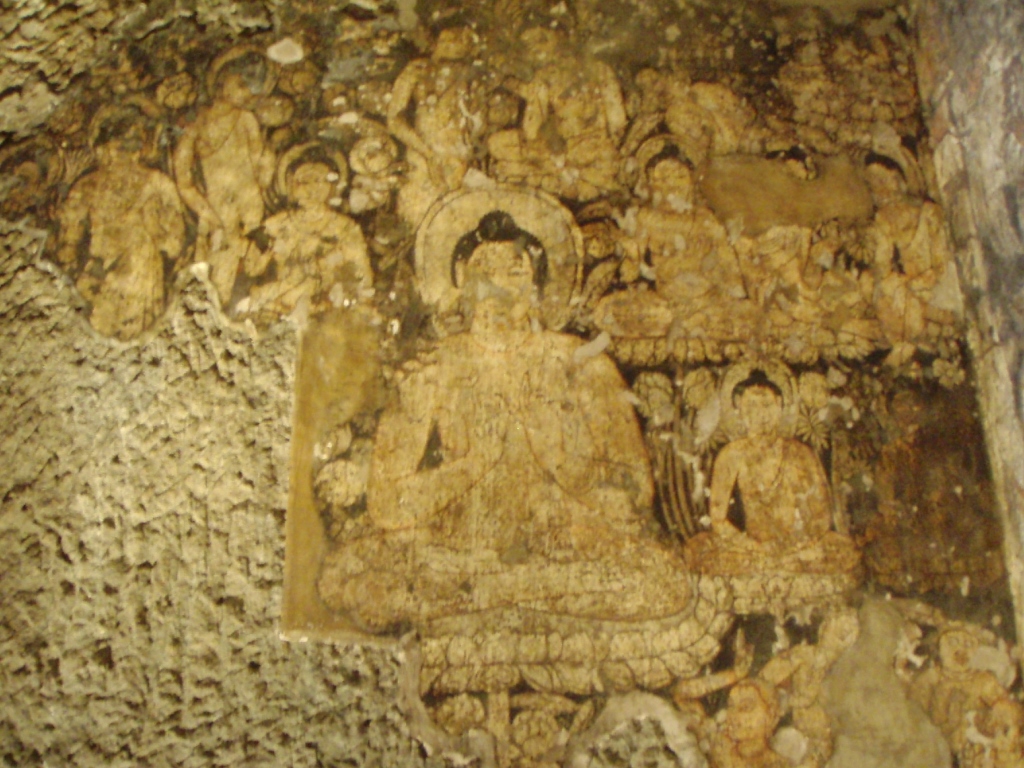 Buddha in Cave no. 6
Buddha in Cave no. 6
Unfortunately, my photographs for different reasons do not even begin to convey the fabulous opulence of the wall paintings in Ajanta Caves and I really hope that I will manage somehow to go again during this lifetime to this part of India and admire them and the impressions which they create in the person when looking at them live.
As a side note, by their spiritual style, Ajanta Caves are also divided into two groups. The first and the earlier group of the caves from the period at the turn of the eras (the end of BCE and the beginning of CE) belongs to the so-called Hinayana phase within Buddhism where Buddha is not depicted in his human form, but symbolically either, for instance, as a stupa or as the Bodhi Tree.
The other group belongs to the Buddhist period Mahayana within which, among other specificities, Buddha is shown in his human form.
This in a way also coincides with the architectural concept I have mentioned above, so the caves from the Hinayana period have the shape of the chaitya-griha in which there is a stupa.
Such is, for example, Cave no. 9 the facade of which is very complex and contains rich decorations, as well as windows. Although it clearly belongs to the Hinayana period, on the side walls it is possible to see large bas-relief depictions of Buddha, which suggests the Mahayana period, so it is considered that these concrete images were added later, in the 5th century.
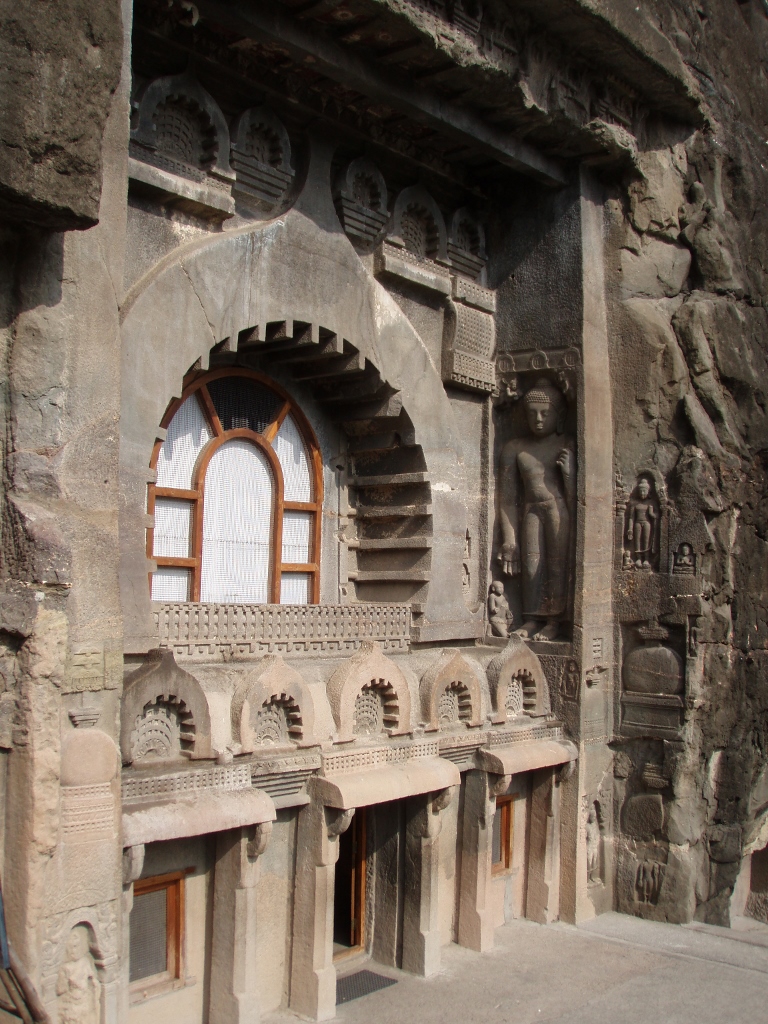 Facade of Cave no. 9
Facade of Cave no. 9
In the back of Cave no. 9 there is a stupa. Stupas have the shape of a mound or are hemi-spherical and by the rule this is the place where the relics were buried, most often those of Buddhist monks and nuns, and later the stupas are used as the place near which people meditate. A lot of stupas stand freely in space, but if a stupa is located within a hall, then such a hall is called the chaitya which is in fact the name for a praying hall or a temple in which there is a stupa.
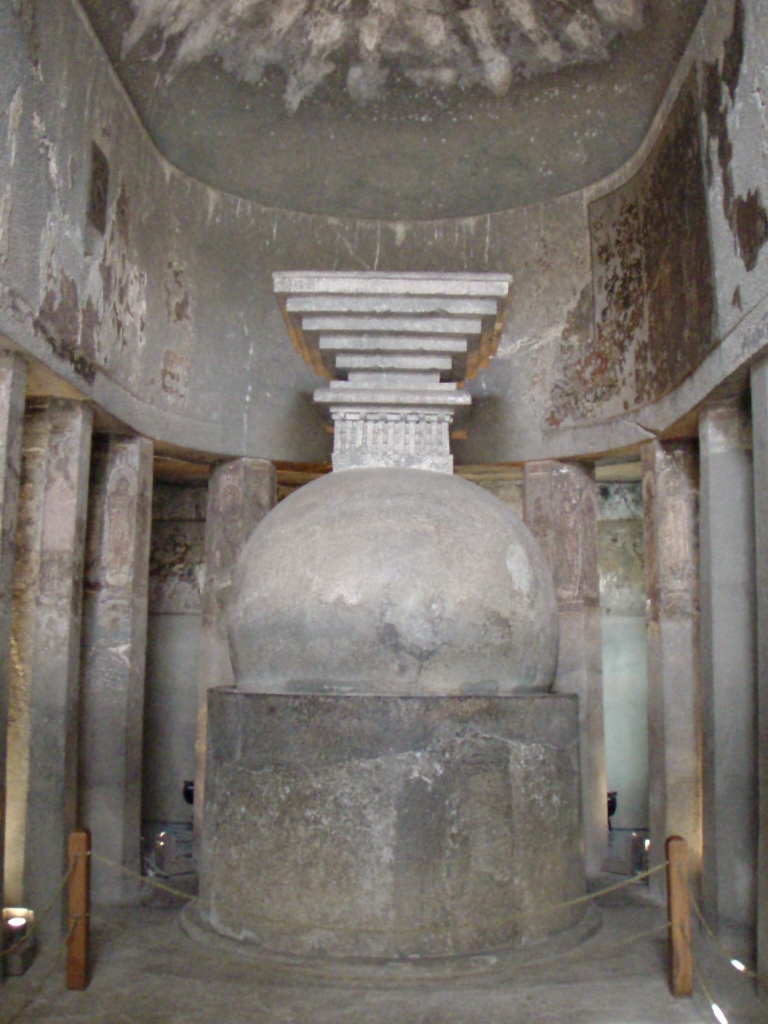 Stupa in Cave no. 9
Stupa in Cave no. 9
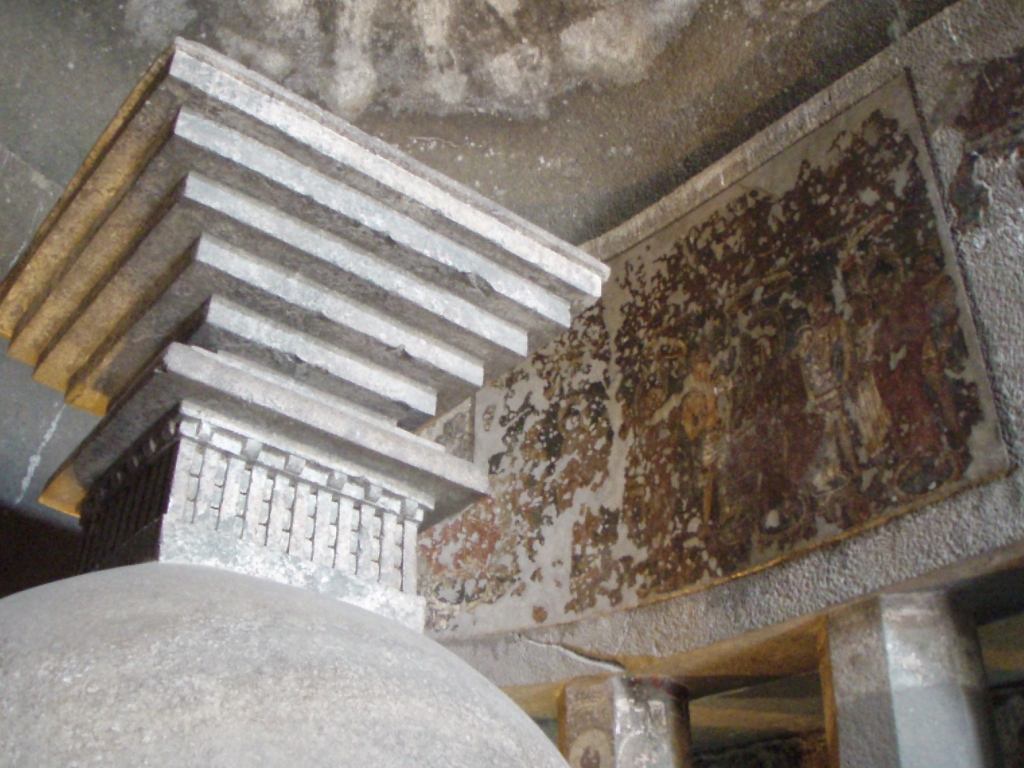 Top of the stupa in Cave no. 9 and a part of the wall paintings
Top of the stupa in Cave no. 9 and a part of the wall paintings